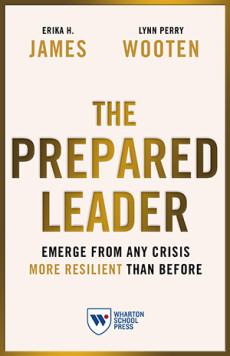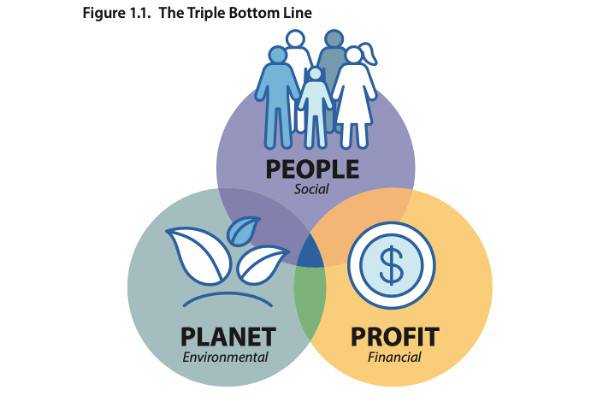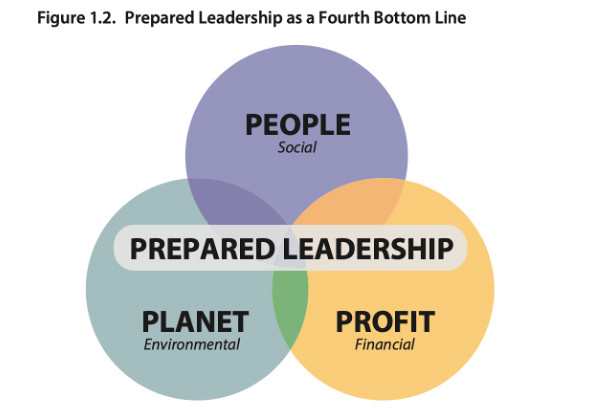
The Prepared Leader: Emerge from Any Crisis More Resilient Than Before
Erika H. James & Lynn Perry Wooten
170 pages, Wharton School Press, 2022
Crises are never one-off events. They happen again and again, though they always seem to catch us off-guard. They shouldn’t. Knowing that crises are inevitable actually empowers us to prepare for them. And the time to prepare for the next crisis is now—and always.
In The Prepared Leader: Emerge from Any Crisis More Resilient Than Before, we argue that as a leader, it falls to you to prepare for the next crisis already facing your organization. It falls to your leadership to develop the protocols and processes, the diversity of perspective and the learning orientation that will empower you to weather the storm on the horizon, and to emerge from the next crisis better than before.
In the following adapted excerpt from our book, we explain how being prepared for crises must become a deeply ingrained leadership habit. And why Prepared Leadership needs to become your “fourth bottom line.”—Erika H. James and Lynn Perry Wooten
* * *
Human beings are poorly designed for crises. We struggle to rationalize hypothetical or ambiguous threats and opportunities; the ill-defined losses and gains that crises foreshadow. We’re also inefficient in our learning. We can be slow to absorb lessons and act upon them, especially when those lessons come from something anomalous, unexpected and unusual. Human beings forget quickly. So great is the relief we feel, the urge to return to life as normal, that we all too easily slip into cycles of panic and neglect, panic and neglect; leaving ourselves vulnerable to the next crisis that is already taking shape around us. Because the thing about crises is that they are inevitable.
Even as you read this, another crisis is already forming on the horizon. Whatever you are managing right now, whether it’s the longtail of COVID-19 or business as usual, something else—big or small—is waiting right around the corner. It could be big or small. It could affect just one part of your organization or it could consume your business. Whatever it is, here’s our message to you: you cannot let your guard down.
The events of 2020 taught us that in our globalized world, crises can evolve with unimaginable stealth and speed. Across our hyper-connected communities and economies, our evolved infrastructures, our complex supply chains, what starts in one corner of our planet can spread to another and another. And it can happen in months, weeks or days. Infectious disease, financial instability, geo-political shifts, inequality, corruption, climate change, a great and globalized resignation—however crises begin in our modern world, we are more vulnerable to contagion than any other time in our history.
That may sound bleak and pessimistic, but the reality is that it’s quite the opposite. As a leader, you have the power to shape the course of the next crisis. You can determine the impact, outcomes and outlook for your organization. You can watch for signs, contain or even deflect the damage, drive recovery and channel all of this into learning—learning that will fortify you and your people for future challenges. There is agency in your leadership. And you can make a difference. But only if you are Prepared.
People, Planet, Profit ... and Prepared Leadership
We are living in times of extraordinary change and uncertainty. Even as the crisis of the pandemic starts to resolve, there are great risks, challenges and opportunities ahead of us. Some are foreseeable, others less so. Technology, innovation and human curiosity continue to power advancement—quantum leaps forward towards unimaginable futures. But there are concomitant hazards ahead too—risks to our well-being and to our very existence on this planet. The stakes couldn’t be higher.
More than any generation of leaders before us, we have a serious responsibility to be better leaders, corporations and organizational citizens. In business, we have long understood the responsibility we have to our shareholders. But we also have a responsibility to service the needs of other stakeholders; of our broader communities, our societies and our environment.
Many of us understand this as a triple bottom line—that it’s no longer enough to focus on the bottom line of profit alone. Good leadership, effective leadership also entails prioritizing and integrating the demands of people and planet: the three Ps, if you will, that should undergird your vision, your strategy, your decisions and your culture.

In business as normal, your triple bottom line—your three Ps—function as your Northern Star, your road map—a stewardship framework that takes you and your organization where you need to go. The three Ps help you plan and navigate as you execute your strategy, in normal times.
But business as normal is an illusion. Business as normal is, at best, intermittent. It is transitory. It can be interrupted and disrupted at any time, in any way and with consequences that are hard for you to imagine.
It took COVID-19 just under two months to overrun our planet. In less than six weeks, it collapsed our economies, emptied our cities and our skies, closed our borders and our schools and colleges, broke our supply chains, and tipped our world into a recession. The pandemic left us with great uncertainty about our future. But it also established absolute clarity about one thing: The unthinkable not only can, but does, happen. And it is likely to happen again.
Whatever its shape or size, whether it’s something that is already smoldering beneath the radar in some area of your business or about to strike with great suddenness and force, there is another crisis ahead of you and your organization. And because of this, you need to be ready to tackle any and every eventuality head on; to brace for the storm ahead, weather its worst and emerge more resilient in its aftermath.
In a perfect, predictable world it would be enough to focus on your triple bottom line—the 3 Ps of people, planet and profit. But in our imperfect, unpredictable, changing and uncertain reality, there is a fourth bottom line—a fourth P—that you need to prioritize and integrate into every aspect of your vision, your strategy, your decisions and culture and your leadership. And that fourth P is being Prepared: Prepared for the next crisis.
Being Prepared will determine whether you survive or not when the unthinkable happens. More than anything else, how Prepared you are as a leader will determine your ability to weather the storm. Prepared Leadership will be the defining factor in how well you can continue to service the needs of people, planet and profit. Because without it, you will struggle to navigate the chaos, uncertainty, and potential for real catastrophe that accompany any crisis.
Prepared Leadership is what will ultimately determine your success, your viability, your longevity or failure when the next crisis strikes you and your organization. Because of this, Prepared Leadership needs to sit at the center of your leadership framework: A fourth P that sustains and bolsters the triple priorities of people, planet and profit.

Being a Prepared Leader is not as simple as expecting the worst and waiting for it to happen. It’s about developing an understanding of the nature of crises and the way that crises unfold. It’s also about challenging your thinking and your decision-making and developing a certain set of skills that will empower you when things are uncertain and time is short. Prepared Leadership is about using all the available tools—the expertise and experience, and the diversity of perspectives—to see a crisis in all of its dimensions and plot out different pathways that can lead you to resolution. It’s about asking questions and listening to answers and capturing the learning opportunities that accompany all crises. And it’s about being open to new experiences, new approaches, to risks as well as rewards.
We believe that Prepared Leadership is at its core about optimism. It is the belief that even in times of crisis, people and organizations can emerge more resilient, stronger and better than they were before.
Becoming a Prepared Leader
We can’t tell you what your next crisis looks like. But we can tell you this: Preparing for the unexpected entails planning for it continuously. That might sound like a very tall order, but it is not only feasible—it can become second nature.
So how do you plan for the unexpected?
First, you need to watch for the signs. You need to scan your environment for changes. That will require you to integrate the mindset and the attitude, as well as the organizational processes, mechanisms, and the leadership skills to read your surroundings and do the requisite scenario planning not only to spot the signals but to make sense of them.
Next, you need to have the right processes and systems in place to enable you and your teams to take evasive actions, if possible, to avoid impact. And if impact is unavoidable, you need to ensure you have the time and space you and your people will need to brace for it adequately.
Once the crisis has hit, you need to have the right mix of capabilities ready and available to help contain or mitigate any damage and limit its spread. You need access to information and knowledge from as many sources as possible to make informed decisions on the go and to ensure those decisions are executed. Communication will need to flow uninterrupted, so you need to have set up your systems and protocols to ensure this happens.
From containing the damage, you need to start to build toward recovery. That means having the information, knowledge, resilience, and creativity in place to set the right goals and objectives, always looking toward the longer term.
Most importantly, you need to be ready and prepared to learn from the crisis. You need to have a learning organizational culture, with processes and protocols in place to surface and share information and to resolve any blockages in knowledge flow. And you need to have procedures in place to capture all the lessons and integrate them into your decisions and planning as you move forward.
Doing these things right will require you to build the teams and relationships forged on trust and openness, and the diversity of skills, knowledge, and perspectives to see the picture as fully as possible. It will also require you to work consciously on your own critical thinking and self-awareness, guarding against bias in your decision-making, deferring to the expertise of others, building the trust to delegate, and enabling collaborative creativity to reframe problems as opportunities wherever possible. It means prioritizing learning from mistakes or failures as they happen. And it means letting go of things that don’t work, shifting and adapting as necessary, and empowering your whole organization to collectively rebuild.
Some leaders already do this instinctively. Others will need to make a conscious effort. For all of us, it implies effort and a willingness to put in the work today that will sustain you and your organization to withstand whatever tomorrow holds.

